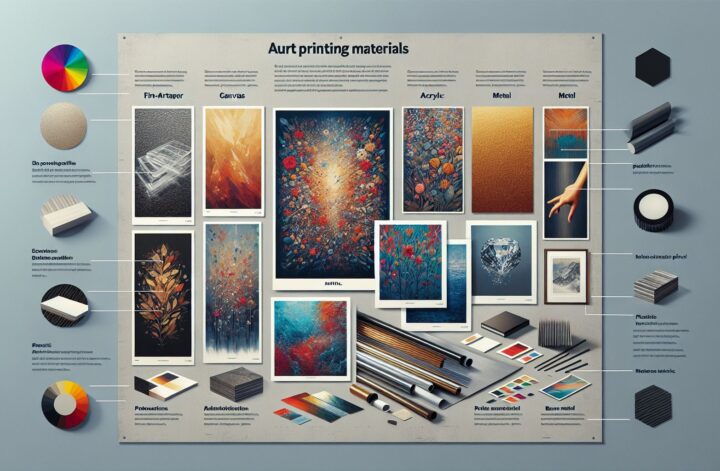Printing has come a long way since the invention of the Gutenberg press in the 15th century. With advancements in technology, the options for printing materials have expanded beyond imagination. Today, we have a vast array of materials to choose from when it comes to printing, each with its own unique properties and applications. In this comprehensive guide, we will explore the world of printing materials, from paper and cardstock to fabrics and plastics, unlocking a myriad of possibilities for your next printing project.
Introduction: The Power of Printing
Printing is a powerful tool that has revolutionized communication, education, marketing, and art. From books and newspapers to flyers and posters, print materials have been instrumental in shaping society. The choice of printing materials plays a crucial role in the overall impact and effectiveness of any project. Whether it’s a business card, a wedding invitation, or a large-scale marketing campaign, the right choice of material can enhance the visual appeal, durability, and functionality of your printed pieces.
The Versatile World of Paper
Paper is the most traditional and widely used printing material, offering countless options to suit various needs. From lightweight, budget-friendly options to premium, heavy-duty varieties, here are some common types of paper used for printing:
-
Bond Paper: Also known as copy paper or printer paper, bond paper is the go-to option for everyday printing needs. It is usually inexpensive and comes in various weights.
-
Matte Paper: Matte paper has a non-glossy, satin-like finish, providing a more subtle and sophisticated look. It is commonly used for brochures, presentations, and high-quality photographic prints.
-
Glossy Paper: Glossy paper has a shiny, reflective surface that enhances color saturation and sharpness. It is ideal for vibrant images, product catalogs, and promotional materials.
-
Cardstock: Cardstock is a thicker and sturdier type of paper, making it perfect for business cards, invitations, and postcards. It exudes a premium feel and can withstand more wear and tear.
-
Recycled Paper: As sustainability gains importance, many printing projects are opting for recycled paper. It may have slightly different texture and color variations due to its eco-friendly composition.
-
Specialty Paper: There is a vast range of specialty papers available, each designed for specific purposes. Some common examples include textured paper for art prints, translucent paper for overlays, and metallic paper for adding a touch of luxury.
The choice of paper depends on various factors such as the desired impact, budget, project requirements, and personal preferences. It’s always a good idea to experiment and test different papers to find the perfect fit.
Exploring Beyond Paper: Alternative Printing Materials
While paper remains the backbone of printing, the world of printing materials has evolved to include a wide range of alternatives. These materials offer unique characteristics and open up new possibilities for creative printing projects. Let’s delve into some popular alternatives:
1. Fabric and Textiles
Printing on fabric and textiles adds a tactile and dynamic element to your designs. It allows you to create personalized clothing, home decor items, banners, and more. There are various techniques for printing on fabric, including:
- Screen Printing: Screen printing involves pressing ink through a mesh screen onto fabric, creating vibrant and long-lasting prints.
- Heat Transfer Printing: Heat transfer printing involves transferring designs from a special paper to fabric using heat and pressure. It is ideal for single-color or multi-color designs on garments and accessories.
- Direct-to-Garment Printing: Direct-to-garment printing utilizes specialized printers to print designs directly onto textiles, offering intricate details and unlimited color options.
2. Plastic and Acrylic
Printing on plastic and acrylic materials opens up a world of possibilities for durable and visually appealing projects. Common options include:
- Vinyl Printing: Vinyl printing involves printing graphics on adhesive vinyl sheets that can be applied to various surfaces like walls, windows, vehicles, and signage.
- Acrylic Printing: Acrylic printing provides a sleek and modern look, often used for creating signage, decorative panels, and custom awards. Designs can be printed directly onto the acrylic or mounted onto it.
3. Metal
Printing on metal offers a unique and luxurious touch to any project. Here are a few techniques commonly used for metal printing:
- Dye Sublimation: Dye sublimation printing involves transferring ink onto a special coated metal surface using heat and pressure. It produces vibrant colors and scratch-resistant prints that are well-suited for photographs and artwork.
- Metal Etching: Metal etching involves using chemicals or lasers to engrave designs onto metal surfaces, creating intricate details and a distinctive finish.
Conclusion: The Key to Impressive Prints
Printing materials are not just the canvas for your designs; they are the key to creating impressive and impactful prints. The options explored in this guide showcase the vast range of possibilities available to you. From traditional paper for everyday printing needs to innovative alternatives like fabric, plastic, and metal, each material brings its own unique charm and functionality.
When choosing printing materials, consider the purpose and aesthetics of your project, as well as factors like durability, cost, and sustainability. Remember, the material you choose can make a significant difference in the overall look and feel of your printed pieces.
So, unleash your creativity and experiment with different printing materials to bring your visions to life. With the right material in hand, you can elevate your designs, captivate your audience, and make a lasting impression. Happy printing!

